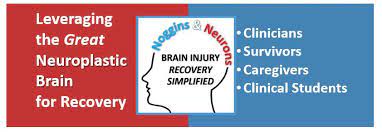19 Aug Neuroplasticity Therapy: Restore Arm & Leg Movement Post Stroke
As a stroke survivor, you may notice motor control difficulties or difficulty controlling movements of your affected arm or leg, but through the process of Neuroplasticity, your brain has the ability to re-wire itself, allowing you to improve these motor skills and accomplish much more.
Physical and Occupational Therapists, trained in stroke rehabilitation, can help you improve motor control of your weakened arm or leg as part of a tailored stroke rehabilitation therapy program, leveraging our “Great Neuroplastic Brains,” which is a term coined by Peter Levine, Author of Stronger After Stroke.
Neuroplasticity is defined as the ability for our brain to create and reorganize connections that were damaged due to stroke. Although a stroke does cause tissue death in the brain, our brain still has the capacity to figure out new paths to improve motor control of the weakened arm or leg…but, IT TAKES WORK!
“There is no doctor, therapist, minister, guru, or Shama in a better position to run your master recovery plan, than you. There is no one who cares as much, so accept the challenge, empower yourself, focus on recovery, work hard, don’t give up, and watch an upward spiral emerge that allows for the highest level of recovery.”
– Peter Levine, Author of Stronger After Stroke
After-Stroke Neuroplasticity Recovery Plan
There are three essential therapy components or objectives for a successful neuroplasticity focused recovery plan to improve motor control after surviving a stroke:
1. General task repetition,
2. New, more challenging tasks, and
3. Tasks that are important to you (not your therapist)!
In order to drive change in your brain and tell it how you want it to improve, repetition of a task is key. The movements you want to relearn should be discussed with your therapist and established as specific goals.
Goals established as part of your neuroplasticity focused recovery plan should be challenging. In fact, they should be so challenging – initially – that you can only perform 7-8 repetitions at a time; lasting no more than one minute. To create lasting change in the brain, this process of task repetition takes time. According to research, it takes 1,200+ repetitions to make the brain relearn how to improve control movement at a specific joint.
Relearning Everyday General Tasks
Let’s say you have a weak right arm, and you want to relearn how to reach out to pick up a book because you love to read. The first joint on the body that is limiting your ability to reach is your elbow. After a stroke, you just don’t have the motor control to fully straighten your arm in the elbow joint area. One task you and your therapist may decide is effective is simply bending and straightening your elbow on a tabletop. In order to reach your 1,200 repetitions, you’ll need to bend and fully straighten your elbow about 100 times a day for 12 days!
This sounds easy in theory but is often very difficult in practice due to the residual weakness of the affected arm.
Accomplishing New, More Challenging Tasks
The second essential recovery objective is assuring the movements you engage in are new and challenging. Once you can perform a general activity, with about an 80% success rate, the activity needs to be upgraded or adjusted to be more challenging.
Let’s use our elbow task of bending and straightening as an example. Once the elbow motion improves, your therapist can upgrade the challenge by having you reach slightly higher or add a light weight to your arm. Ultimately, the goal is to provide challenging repetitions, so your brain is given the opportunity to improve motor control.
Ensuring Recovery for Meaningful Tasks
Lastly, and in some cases more importantly, an effective neuroplasticity focused recovery plan must include therapy objectives aimed at improving motor control for tasks that are salient or at a high level of importance to you personally. Being expected to perform a task 1,200 times that holds no real importance or value can feel meaningless and probably won’t be performed as diligently as it should be. With that said, reaching for a book might only be an effective rehabilitation objective for those who love to read, which in this case, a real book should be on the table and a part of each level of task repetitions.
After-Stroke Neuroplasticity Recovery Time
Unlike some rehabilitation programs, there is no such thing as a six-moth neuroplasticity focused rehabilitation program after surviving a stroke. Stroke recovery can take several weeks, months, and even years, which all depends on the uniqueness of the stroke and the survivor. The amount of hard work you decide or are able to put into your recovery is what will make the greatest difference in your recovery time.
The important thing to remember when it comes to stroke recovery, specifically neuroplasticity focused rehabilitation, is that it will take more time than you imagined and harder work than you thought you could ever accomplish, but you CAN do it and when you do, it will be worth it. While the stroke recovery goals that you want to accomplish are yours and yours alone, with the right therapist, together you can reach long-term success in improving the motor skills you relied on before your stroke and position yourself for much more by leveraging your Great Neuroplastic Brain!
We can help!
If you or someone you care for is looking for a therapist trained in stroke rehabilitation, we can help! Our very own Jennica Colvin and Suzanne McCrum are both certified in stroke rehabilitation therapy. Give us a call today to make an appointment to see either of our Certified Stroke Rehabilitation Therapists.

Jennica Colvin, Owner & Occupational Therapist
Trio Rehabilitation & Wellness Solutions
Boerne, Texas



